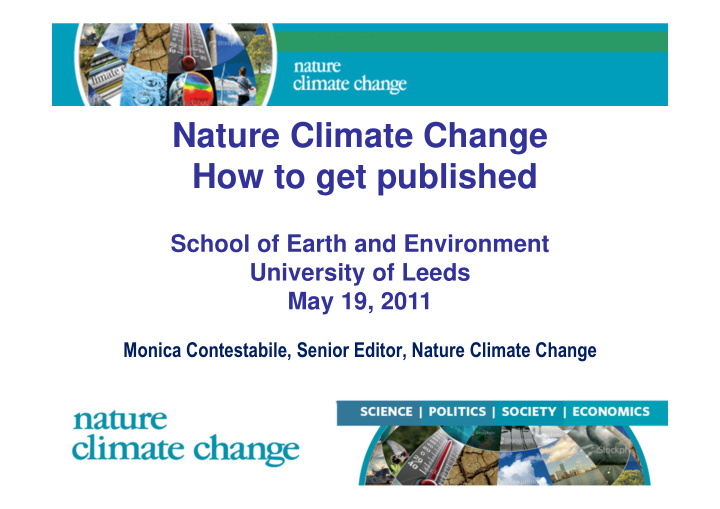



Nature Climate Change How to get published School of Earth and Environment University of Leeds May 19, 2011 ���������������������������������������������������������
Scope and Focus Scope is climate change, its impacts and implications for the economy, policy and society Focus is specifically on contemporary and future climate change
Key facts • First issue March 29, 2011 • 12 issues per year • Online and print (recycled paper) • Impact factor due in 2013 • 4 in-house editors • External advisory board • Standard peer review process • OTR rate 24%, accept rate TBC
Team • Chief Editor: Olive Heffernan (climate impacts on ecology, biodiversity, resource management, policy) • Senior Editor: Jo Thorpe (atmospheric science, palaeoclimatology, climate policy) • Senior Editor: Monica Contestabile (social science including economics, policy) • Associate Editor: Alastair Brown (climate impacts, adaptation, vulnerability) • External Advisors • Publisher: Ruth Wilson
External Advisory Board • All decisions made by in-house editors • Ten external advisors to advise on publishing social science • In areas covering psychology, anthropology, sociology, policy, economics, adaptation, development, vulnerability etc. • Suggest referees, topics for review, encourage submissions and occasionally review articles and advise on editorial thresholds.
Content • Original research in the natural and social sciences, plus original interdisciplinary research • Review articles on frontier topics • Opinion and analysis from thought leaders in business, academia and policy • Market and policy analyses • Original reporting from renowned journalists
Comparison to other Nature titles •Like Nature and Nature Geoscience , Nature Climate Change publishes original research on understanding of the physical climate system. • Nature Climate Change focuses exclusively on contemporary climate change, so palaeoclimate research is usually considered only if it is furthering our knowledge on modern and future climate. •And publishes much that neither Nature nor Geoscience would publish •Social science research •Research that has substantive/groundbreaking implications for policy, the economy etc but not as great a scientific advance as research published in Nature
Submitting to Nature Climate Change •Pre-submission enquiries: referenced abstract only •Full letters (2,000 words) and articles (2,000 -3,000 words) •Reviews and Perspectives (3,000-4,000 words; usually commissioned; proposals welcome and should include background, summary, key references and list any previous reviews on the topic) • Commentary ( ≤ 1,500 words; almost always commissioned, though enquiries welcome in the form of a 200 word summary to the editor; commentaries may be peer-reviewed at the editors’ discretion)
Criteria for publication •Novelty – work must represent a conceptual advance in understanding of climate change or of its impacts and/or implications for policy, society and the economy •Broad interest – the findings must be of interest to the wider climate research community, spanning atmospheric science to anthropology •Scientifically robust – determined during peer review
Peer review process •Standard Nature RJ peer review process; single blinded •Interdisciplinary papers usually have more than 3 referees, however, depending on the diversity of expertise on the paper •Double blind; may be something we trial in the future
Social science • Submissions strong in certain areas such as behavioural research; less so in others such as economics • Format may present a problem; used to longer articles and used to discursive essay-type articles. • Criteria for publication (in terms of clear advance in understanding) not always obvious, nor even claimed. Findings often intuitive.
Published so far • A review on the role of social and decision sciences in communicating uncertain climate risks (most visited in issue 1) • One social science paper on how experience of extreme weather events can influence willingness to save energy, with N&V (most emailed paper) • One interdisciplinary paper on the economic and human impacts of stringent vehicle emissions standards in developing countries • A correspondence on a scientometric analysis of the climate lit • Lots of front half content including features, unlinked N&Vs on policy (CDM) and social learning (around CCS), opinion (carbon labelling) and analysis (on policy and adaptation), reviews, highlights.
Other titles Launch Predominant disciplinary Impact Journal Year scope Factor Publisher Theoretical and Applied Climatology 1948 Climatology 1.776 Springer American Meteorological Journal of Applied Meteorology and Climate 1962 Meteorology and climatology 1.894 Society Climatic Change 1977 Inter-disciplinary 3.635 Springer International Journal of Climatology 1981 Climatology 2.347 Wiley Atmospheric, physical Geophysical Research Letters science 3.204 AGU Global Change Biology Ecology 5.561 Wiley Global Environmental Change Inter-disciplinary 3.340 Elsevier Climate Dynamics 1986 Meteorology and climatology 3.917 Springer American Meteorological Journal of Climate 1988 Meteorology and climatology 3.363 Society Climate Research 1990 Climatology and geography 2.25 Inter-Research Climate Policy 2001 Policy Sciences 1.402 EarthScan Climate and Development 2009 Development sciences EarthScan American Meteorological Weather, Climate and Society 2009 Social Sciences Society WIRES Climate Change 2010 Inter-disciplinary Wiley-Blackwell
www.nature.com/nclimate .
Recommend
More recommend